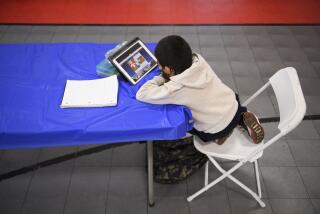Cutting the Cord
MOUNTAIN VIEW, Calif. — It’s around noon on a busy Friday when Rick Potts, a software engineer at Netscape Communications Corp., walks into the Dana Street Roasting Co. and gently sets his laptop computer on a table near the front door. He turns it on and quickly links to a wireless high-speed Internet connection.
There are a lot of coffee bars in the Silicon Valley that let you do this sort of thing, but Dana Street is different. Here the connection is free, courtesy of a computer sitting benignly underneath a sink behind the counter.
“I just like to come here and work sometimes,” Potts said. “I enjoy the flexibility. It makes for a nice work experience.” In addition to work, he can check in with friends, see what’s playing at the movies and make a dinner reservation.
Potts and hundreds of others have used the Dana Street wireless Internet pipe in the months since local technology entrepreneur Ross Finlayson installed it so he could use the coffee shop as a second office. “I basically set it up as a convenience for me,” he said. “But it turns out lots of other people find it convenient too.”
Finlayson, and thousands like him all over the world, are crafting a new vision of Internet access, a cooperative, community-based endeavor that provides wireless high-speed bandwidth, eliminating monthly fees charged by telephone and cable companies.
These activists are cobbling together systems in garages and attics, taking the wired high-speed connections that come into their homes and throwing them open to neighbors. This utopian vision of free, high-speed access, any time and anywhere, is rooted in the earliest days of the Internet, when colleges and universities freely pooled computing resources and made them available to anyone connected to the system.
“We are putting these things out there and creating communities,” said Tim Pozar, a San Francisco telecommunications engineer who is at the forefront of the movement in the Bay Area.
Pozar, 43, helped create one of the earliest Internet service providers a decade ago by stringing cables through San Francisco neighborhoods. People didn’t see the importance of Internet access until they had it, and once they had it, they wanted more. He sees providing cutting-edge technology to people who otherwise would not have access as a moral imperative.
“One of my main themes in life is to give tools to the world that help people express their ideas,” Pozar said. “If everyone has the tools to exchange ideas, then the world will be a better place as misconceptions, government and corporate propaganda and restriction of communications will have less of an impact on the world.”
Pozar began the quest for high-speed wireless distribution last year by sharing his Internet connection with a neighbor, another telecommunications engineer, Bill Ruck, who lives about a quarter of a mile away. It cost about $1,000 for all the gear, but today it would cost no more than $400 to broadcast a signal.
The transmissions that come from the modest antenna barely visible on the roof of Pozar’s home in San Francisco’s Sunset district can be picked up by any computer equipped with what’s known as an 802.11b wireless card-a small plug-in device available for less than $100. Under the right conditions and with the proper equipment, such signals can be effective up to 20 miles away. In an urban area with heavy masonry buildings, the signal might cover half a block.
Pozar’s broadcast began innocently enough as an experiment. “Now we know it can work, and people can share computing resources with their neighbors,” Ruck said. “It’s also a way of building a community and getting to know the people around you.”
Community is a word that comes up a lot with these activists, who hope that technology can help bring Americans closer together.
“There is a community vacuum in America,” said Russ Travis, a professor of sociology and social psychology and the history of technology at Cal State Bakersfield. “In the past, before we all moved around so often, people experienced a sense of connection, a sense of place. Now, it takes a war to bring us together.”
The government recognized the importance of the telephone to society decades ago and crafted a system that offered subsidized service at such low rates that today more than 96% of homes in America have telephone service. But no such subsidy plan exists for Internet access, much less high-speed service.
Pozar believes that he, and others like him, can succeed in evangelizing high-speed wireless connections just as they’ve succeeded with standard Internet access. “I’ve done this before,” he said. “I think I can do it again.”
The model is springing up in urban areas around the world, but it’s really taken hold on the West Coast, especially around San Francisco and Seattle.
Matt Westervelt, a computer systems administrator in Seattle, is helping build a wireless metropolitan computer network using off-the-shelf hardware and free software that won’t require users to pay recurrent fees to a telecommunications company.
“In a standard telco model, you are wired in by a corporation,” he said. “You have no controls and no contribution. You are charged for your monthly allotment of bandwidth.
“In our model, infrastructure is built by the users of the network. Peering within the Seattle Wireless network is free. You can put up any service you like for a very small upfront cost for gear and no recurring fee. Being part of the infrastructure ensures that you will have a connection as long as there is a network. We feel that this model is more sustainable over the long term.”
The project currently has nine broadcast points that have hosted hundreds of users in the year it’s been active.
Others, including Pozar, hope to form cooperatives, in which users still pay for high-speed access but at a price lower than, or at least competitive with, commercial service. “I figure we break even at 48 people, and after that the costs go down for everybody involved,” Pozar said. “I think we have the critical mass necessary to do this.”
One of those interested in Pozar’s project is David L. Sifry, who lives nearby. Sifry, chief technology officer for a Silicon Valley start-up, pays $200 a month for a wire conveying high-speed Internet access-known as broadband-to his home. He said Pozar’s project couldn’t come at a better time.
“The availability of broadband to the home is diminishing, not increasing,” said Sifry, reeling off a list of providers that have gone out of business or declared bankruptcy over the last year.
The community-building aspect of the enterprise is what excites Sifry. “We can create a shower of bandwidth for the residents of San Francisco and do so in a way that bypasses these companies,” he said. “This is a huge opportunity for citizens to lower the barriers facing people who should have access to this technology but don’t.”
Predictably, some Internet service providers are not happy about the movement. Many companies that offer such services as digital subscriber line forbid subscribers from reselling or giving away the signal.
But some people who are active in the free-wireless movement say they do so anyway.
“I have a wireless antenna up. I let anybody who wants to tap into it do so, and there’s nothing my ISP can do about it,” said one activist who agreed to talk only if he is not identified.
Some ISPs are taking steps to stop such activity. AT&T; Broadband is hoping for a change in laws that will let it seek criminal charges against users who violate their contracts. “If you are giving your service away to other people, that is fraud,” said Sarah Eder, a spokeswoman for AT&T; Broadband. “Obviously, some people are doing this because they perceive some social benefit, but it’s like taking your cable TV line and splitting it up into every apartment in your building.”
A lack of clarity in the law makes any criminal aspect to this activity vague, Eder acknowledged. The most the company could do legally is cut off an individual for inappropriate use and perhaps sue to recover damages.
Pozar and other leaders in the movement discourage people from pirating signals and urge everyone involved to obey the law. Participants should simply drop ISPs that don’t allow for the redistribution of the signal, he said.
“There’s no reason to create more problems for yourself,” Pozar said. “This technology is incredibly powerful, and we need to get it into the hands of as many people as we can.”
*
Dave Wilson is The Times’ personal technology columnist. He can be reached at dave.wilson@latimes.com.






